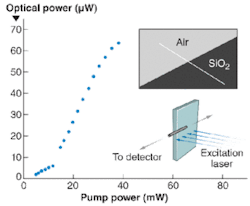Nanowires only hundreds of nanometers in diameter have yielded the first direct evidence of laser action, says professor of engineering Federico Capasso and colleagues at Harvard (Cambridge, MA). Global advances in materials and fabrication are credited with enabling scientists to observe direct evidence of laser action in nanowires through a study of the transition from amplified spontaneous emission (ASE) to laser oscillation above threshold.1
Until now, evidence of the laser threshold between the superlinear region characteristic of ASE and the linear region characteristic of laser oscillation has been elusive. Moreover, previous observations did not measure the highly directional light coming from the end of the nanowire—an important characteristic of lasers. Along with researchers at the University of Gö ttingen (Gö ttingen, Germany), and the University of Jena (Jena, Germany), the Harvard group found unambiguous evidence of optically pumped lasing at ultraviolet frequencies in individual zinc oxide (ZnO) nanowires at room temperature, and measured it using a “head-on” geometry.
Using a simple vapor-transport technique, the team synthesized single-crystal ZnO nanowires of various dimensions, from 3 to 23 µm in length and approximately 100 to 375 nm in diameter. Then, they sent frequency-tripled, 355 nm light from an yttrium aluminum garnet (Nd:YAG) laser at 500 Hz and 6 ns pulse length into the individual nanowires, focused to a beam diameter of 100 µm. They used a reflective microscope objective coupled to a spectrometer and a charge-coupled device (CCD) to capture the emission from the nanowire ends.
The emergence of lasing
At pump intensities leading up to approximately 200 kW/cm2, the hump-shaped featureless optical spectra at a center wavelength of approximately 382 nm was characteristic of spontaneous emission, with a broad full-width half-maximum of 19.3nm. Here, light was emitted isotropically along the nanowire, and the output was linearly dependent on the excitation intensity, as expected for spontaneous emission.For pump intensities between 200 kW/cm2 and 300 kW/cm2, broad emission with emerging sharp emission lines indicated the building of population inversion and the beginnings of longitudinal-mode ASE along the nanowire. In this range, the output power was superlinear with respect to pump intensity—indicative of approaching the laser threshold. Above 300 kW/cm2, the spectral emission narrowed to a band between 385 and 390 nm, and the sharp emission lines were orders of magnitude greater than the spontaneous background emission, indicating unambiguous laser oscillation in the nanowires. The output power returned to the signature linear dependence on excitation intensity, which is expected for lasing above threshold (see figure).
“We obtained optical power output that clearly exceeds the background emission. This, along with the linear increase in power above threshold, is conclusive evidence for lasing never before obtained in nanowires,” says Capasso.
Furthermore, suspending the nanowires off the edge of a silicon substrate enabled the silicon detector to directly record “head-on” emission from the end of the nanowire—up to 60 µW at a 10% collection efficiency. In addition, the group found a key threshold minimum nanowire diameter of 150 nm that is necessary for lasing, independent of length.
Applications for such tiny lasers could be in medical applications, or in quantum information processing. “A synthesized cavity size means these lasers are very controllable. We may someday use tiny lasers like this to probe living cells in vitro and trigger optically active receptors to investigate cell responses and pathways. We could realize the development of the first circularly polarized laser via injection of spin-polarized electrons along the nanowire using a ferromagnetic contact. It would also be tantalizing to see nanowire lasers coupled into quantum dots.”
The next milestone, according to Capasso, is to make these lasers electrically pumped at room temperature. “That will be the challenge.”
REFERENCE
- M. Zimmler et al., Appl. Phys. Lett. 93, 051101-1 (online Aug. 4, 2008).

